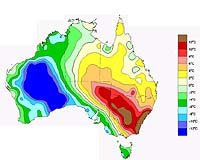| . |  |
. |
Research Triangle Park NC (SPX) Jun 16, 2009 A research article published in the peer-reviewed journal Environmental Health Perspectives (EHP) describes an approach to identify which U.S. populations within specific geographic regions are likely to be most susceptible to adverse effects of heat, as well as which areas are most in need of intervention. With reports of heat waves increasing in frequency, intensity and duration worldwide, cities can use information on vulnerable at-risk populations to help coordinate heat emergency plans and identify interventions to reduce the preventable and negative health effects of heat waves. This information can ultimately be used to design longer-term interventions to lessen vulnerability to heat-related illness, for example by increasing urban green spaces (outdoor areas with an abundance of vegetation). The study gathered available information on several factors that have been associated with adverse health impacts from heat waves to identify vulnerable populations. These factors included lower education, poverty, being a race other than white, lack of green space, living alone, lack of air conditioning, older age and presence of diabetes. These data were compiled into a national map of county-level heat vulnerability. This map suggested that heat vulnerability could vary widely across the nation, due primarily to differences in air conditioning prevalence. In urban areas, inner cities were likely to be more vulnerable to heat regardless of the city's overall vulnerability. These maps would need to be validated by comparison with actual observed outcomes in response to heat. Studies of heat waves and mortality in the United States have shown that increases in mortality from heat-related causes, cardiovascular causes, respiratory causes, heart attacks and all causes combined occur on days with higher temperatures or extended periods of high temperatures. Pre-existing health conditions may lead to vulnerability to heat-related illnesses and death in individuals. These conditions include cardiovascular disease, diabetes, renal disease, nervous disorders, emphysema, epilepsy, cerebrovascular disease, pulmonary conditions and mental health conditions. However, community-level factors, such as poverty and a lack of ground cover, may also increase vulnerability. "This study is a novel approach to map vulnerability to a health outcome related to climate change nationally and can be considered a first step towards tools that can help public health professionals prepare climate change adaptation plans for their communities," wrote first author Colleen Reid and colleagues. "In addition to refinement of this method for heat vulnerability, further studies mapping vulnerability to other projected health impacts of climate change are needed." EHP editor-in-chief Hugh A. Tilson, PhD said, "Because heat waves are projected to increase in frequency, duration and intensity in the United States and around the world, it is critical that municipalities at the local level develop effective heat warning systems, emergency planning procedures and interventions that focus on groups that are most vulnerable, like the elderly." Other authors of the paper included Marie O'Neill, Carina Gronlund, Shannon Brines, Dan Brown, Ana Diez-Roux and Joel Schwartz. The study was funded by the U.S. Environmental Protection Agency. Share This Article With Planet Earth
Related Links Environmental Health Perspectives (NIEHS) Weather News at TerraDaily.com
 Australia heatwave may have killed up to 374: officials
Australia heatwave may have killed up to 374: officialsMelbourne (AFP) April 6, 2009 A once-in-a-century heatwave in the Australian state of Victoria in late January contributed to as many as 374 deaths, official data released Monday showed. The Victoria state government said there were 980 deaths in the final week of January, 374 higher than the average over the same period in the previous five years. The rise in fatalities was higher than the toll of 173 who died when ... read more |
|
| The content herein, unless otherwise known to be public domain, are Copyright 1995-2009 - SpaceDaily. AFP and UPI Wire Stories are copyright Agence France-Presse and United Press International. ESA Portal Reports are copyright European Space Agency. All NASA sourced material is public domain. Additional copyrights may apply in whole or part to other bona fide parties. Advertising does not imply endorsement,agreement or approval of any opinions, statements or information provided by SpaceDaily on any Web page published or hosted by SpaceDaily. Privacy Statement |